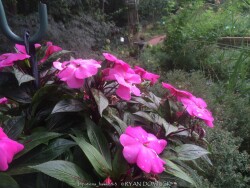

***Description for this plant available with future update!***
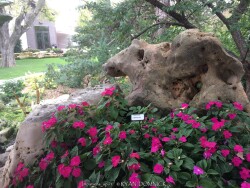

***Description for this plant available with future update!*** This plant can also be used as a marginal aquatic plant growing in shallow water. It can also grow as a bog plant needing constantly moist soil rich in organic matter. As a rain garden plant, it will thrive is a depressed area in the landscape that collects rain water from a roof during spring and summer periods of rain but then go dormant if the water hole dries out completely.
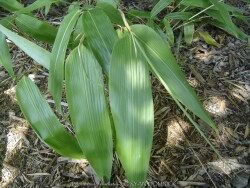

Largeleaf Groundcover Bamboo / Indocalamus, is also known as Indocalamus tessellatus
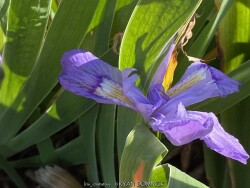

***Description for this perennial available with future update!***
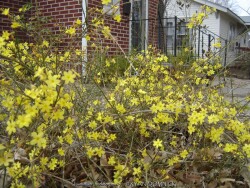

Winter Jasmine (Jasminium nudiflorum) is a spreading dwarf shrub native to China. It features dark green glossy leaves that remain attractive all summer. The density of the shrub overtime is unmatched, completely eliminating any weeds including tree seedlings from emerging. Bright yellow five-petaled flowers resembling forsythia bloom extremely early in the spring usually in February or March before foliage growth (in Lawrence, KS). Flower buds are hardy to about 0° so flowering may not occur every year if temperatures get lower. Occasionally this shrub will bloom in the middle of winter when we have a 2-3 week warm spell. When it does bloom, it creates a spectacular show completely covering the shrub. It will grow in full sun or full shade in medium to dry soils including some dry-shade. It tolerates moist soils and brief periods of saturated soils after heavy rains. Fall color is yellow but drops quickly. Stems take on an olive greenish color in winter rendering them mildly attractive. Winter jasmine is commonly grown as a spreading groundcover shrub for difficult areas, frequently used as large mass planting on hills. Because of its tolerance for adverse conditions including poor soil and rock, it is often one of the last resort plants that will survive in certain areas. It competes well under large shade trees and helps absorb leaf litter allowing it to break down and add nutrients back to the soil. This plant also does well in hot dry parking lot islands, hell strips, and along busy roads in full sun. Another great spot is planting on top of a retaining wall allowing it to cascade down. Further uses include erosion control and streambank stabilization. We do not recommend planting in small areas or in spaces that it will overrun neighboring plants. It only spreads above ground as horizontally growing stems touch the ground and root. This does make maintenance easier to control the spread of the plant versus digging out rhizomes. Avoid North exposures and wet soils. Considered one of the most versatile and best plants for solving difficult landscape challenges.
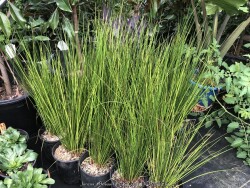

>>>>>This plant can also be used as a marginal aquatic plant growing in shallow water. It can also grow as a bog plant needing constantly moist soil rich in organic matter. As a rain garden plant, it will thrive is a depressed area in the landscape that collects rain water from a roof during spring and summer periods of rain but then go dormant if the water hole dries out completely.


***Description for this plant available with future update!*** This plant can also be used as a marginal aquatic plant growing in shallow water. It can also grow as a bog plant needing constantly moist soil rich in organic matter. As a rain garden plant, it will thrive is a depressed area in the landscape that collects rain water from a roof during spring and summer periods of rain but then go dormant if the water hole dries out completely.
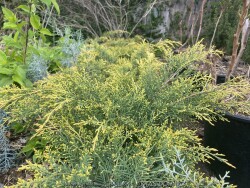

***Shrub descriptions available with future update!***
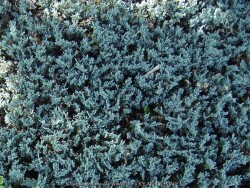

***Shrub descriptions available with future update!***
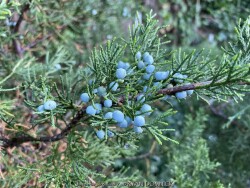

Eastern Red Ceder, is also known as Juniperus virginiana


***Tree descriptions available with future update!***
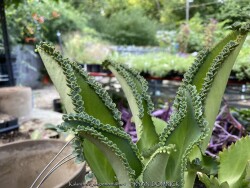

Mother of Thousands (Kalanchoe daigremontiana) is a very unusual succulent (and sometimes a weed) grown for its beautiful symmetrical foliage with neatly aligned babies (offspring) growing along the leaf edges. Tall orange flowers emerge from larger mature pot grown plants. Usually used as a patio or house plant in Kansas, they can also be grown as an annual. Grow in full sun to part sun with optional extra watering including that which comes from rainfall. Plants with time to acclimate will thrive in full sun but be careful not to rush it or sunburning will occur. Generally if moving outside for the summer, allow 2-3 weeks of part shade or morning sun before placing in full sun. Repotting may or may not be needed depending on how large you want the plant to grow; plants can continue to grow and tolerate extremely root-bound pots. Protect from temperatures below 35 degrees F and move into a bright window over the winter with no watering. Do not allow Mother of Thousands grown in pots to freeze solid or get close to freezing especially if soil is wet or death may occur. As a winter house plant, it will look presentable all winter long with just a few monthly or no waterings if you forget. As a permanent house plant, provide bright light and allow the soil to dry between waterings for many years of carefree enjoyment. Note that Mother of Thousands is called so because "babies" constantly fall off the mother plant and can become weeds in your other succulent plants. This is mostly interesting (especially for kids) to see how some plants can propagate. Undesired plants can easily be pulled out and given to a new home.
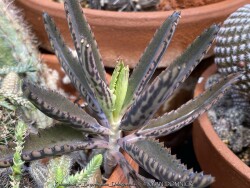

Mother of Millions (Kalanchoe delagoensis) is a very unusual succulent (and sometimes weed) grown for its beautiful symmetrical foliage with neatly aligned babies(offspring) growing along the leaf edges. Tall orange flowers emerge from larger mature pot grown plants. Usually used as a patio or house plant in Kansas, they can also be grown as an annual. Grow in full sun to part sun with optional extra watering including that which comes from rainfall. Plants with time to acclimate will thrive in full sun but be careful not to rush it or sunburning will occur. Generally if moving outside for the summer, allow 2-3 weeks of part shade or morning sun before placing in full sun. Repotting may or may not be needed depending on how large you want the plant to grow; plants can continue to grow and tolerate extremely root-bound pots. Protect from temperatures below 35 degrees F and move into a bright window over the winter with no watering. Do not allow Mother of Millions grown in pots to freeze solid or get close to freezing especially if soil is wet or death may occur. As a winter house plant, it will look presentable all winter long with just a few monthly or no waterings if you forget. As a permanent house plant, provide bright light and allow the soil to dry between waterings for many years of carefree enjoyment. Note that Mother of Millions is called so because "babies" constantly fall off the mother plant and can become weeds in your other succulent plants. This is mostly interesting (especially for kids) to see how some plants can propagate. Undesired plants can easily be pulled out and given to a new home.
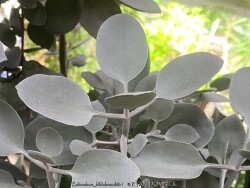

The silver foliage color of (Kalanchoe hildebrandtii) steals the show. Usually used as a patio or house plant in Kansas, they can also be grown as an annual if purchased in bulk. Grow in full sun to part sun with optional extra watering including that which comes from rainfall. Plants with time to acclimate will thrive in full sun but be careful not to rush it or sunburning will occur. Generally if moving outside for the summer, allow 2-3 weeks of part shade or morning sun before placing in full sun. Repotting may or may not be needed depending on how large you want the plant to grow; plants can continue to grow and tolerate extremely root-bound pots. Protect from temperatures below 35 degrees F and move into a bright window over the winter with no watering. Do not allow Silver Teaspoons plant grown in pots to freeze solid or get close to freezing especially if soil is wet or death may occur. As a winter house plant, it will look presentable all winter long with just a few monthly or almost no waterings if you forget. As a permanent house plant, provide bright light and allow the soil to dry between waterings for many years of carefree enjoyment. Potted plants are very low maintenance and tolerant of indoor environments. This is not at all a big-box store plant so be prepared to expand your plant palette with Silver Teaspoons!


The foliage color, texture and patterns make Paddle Plant (Kalanchoe luciae) an excellent architectural specimen. Usually used as a patio or house plant in Kansas, they can also be grown as an annual. Grow in full sun to part sun with optional extra watering including that which comes from rainfall. Plants with time to acclimate will thrive in full sun but be careful not to rush it or sunburning will occur. Generally if moving outside for the summer, allow 2-3 weeks of part shade or morning sun before placing in full sun. Repotting may or may not be needed depending on how large you want the plant to grow; plants can continue to grow and tolerate extremely root-bound pots. Protect from temperatures below 35 degrees F and move into a bright window over the winter with no watering. Do not allow Paddle plant grown in pots to freeze solid or get close to freezing especially if soil is wet or death may occur. As a winter house plant, it will look presentable all winter long with just a few monthly or no waterings if you forget. As a permanent house plant, provide bright light and allow the soil to dry between waterings for many years of carefree enjoyment. Potted plants are very low maintenance needing only old leaves trimmed once per year. This is not at all a big-box store plant so be prepared to expand your plant palette with Paddle plant!
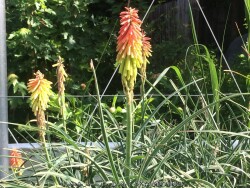

***Description for this perennial available with future update!***


***Description for this perennial available with future update!***
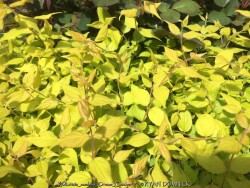

Dream Catcher Beautybush, is also known as Kolkwitzia amabilis 'Dream Catcher'
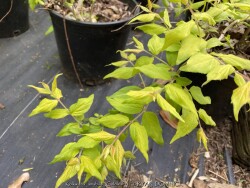

Goldleaf/Golden Beauty Beautybush, is also known as Kolkwitzia amabilis 'Goldleaf'


Dream Catcher Beautybush, is also known as Kolkwitzia amabilis 'Dream Catcher'
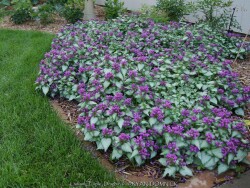

>>>>>Ultra cold-hardy plants from northern climates normally dislike our long hot humid summers; although we are on the Southern edge of this plants adaptability, it still survives reasonably well here. Look for a cold microclimate planting location such as East or North exposure.>>>>>
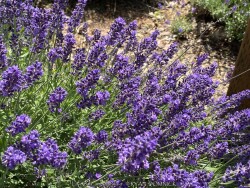

Lavender (Lavandula angustifolia 'Munstead') is one of the most well-known flowers and herbal qualities. It features grayish green aromatic and evergreen foliage with lavender flowers. Blooming usually starts during the heat of summer and continues until frost. Lavender is native to Mediterranean climates with average moisture in the summer and dry, mild winters. Because of its heritage, it resents cold wet winters and needs well drained sandy, silty, or rocky soil. In the short term, it will typically grow in any soil during the summer making it very useful even as an annual. In Kansas landscapes, it is commonly used as an annual or short-lived perennial where lots of color is needed in full sun. Root rot is likely when placed in poor draining soil or even in rich garden soil. Summer heat is usually not a problem but not extreme heat of a south or west wall. Lavender does reasonably well growing out of retaining walls or on top of retaining walls with perfect drainage. Lavender is actually a woody shrub but grown like a in perennial because every so often do you need to trim it back to a few inches off the ground. Lavender combines nicely with any red, orange, or yellow flower or where needing a perennial with evergreen winter color. Lavandula angustifolia 'Munstead' is a commonly sold cultivar.


Lavender is one of the most well-known flowers and herbal qualities. It features grayish green aromatic and evergreen foliage with lavender flowers. Blooming usually starts during the heat of summer and continues until frost. Lavender is native to Mediterranean climates with average moisture in the summer and dry, mild winters. Because of its heritage, it resents cold wet winters and needs well drained sandy, silty, or rocky soil. In the short term, it will typically grow in any soil during the summer making it very useful even as an annual. In Kansas landscapes, it is commonly used as an annual or short-lived perennial where lots of color is needed in full sun. Root rot is likely when placed in poor draining soil or even in rich garden soil. Summer heat is usually not a problem but not extreme heat of a south or west wall. Lavender does reasonably well growing out of retaining walls or on top of retaining walls with perfect drainage. Lavender is actually a woody shrub but grown like a in perennial because every so often do you need to trim it back to a few inches off the ground. Lavender combines nicely with any red, orange, or yellow flower or where needing a perennial with evergreen winter color. Lavandula angustifolia 'Munstead' is a commonly sold cultivar.
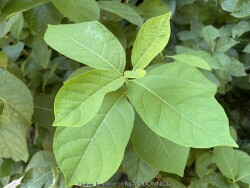

Native Spicebush (Lindera benzoin) is a multi-stemmed, irregularly rounded understory shrub native to eastern North America, including Eastern Kansas. Foliage is a matte bright green then turning an attractive yellow in autumn. The yellow flowers grow in showy clusters appearing in early spring before foliage emerges. Flowers on male and female plants look noticeably different. The flowers have sepals in place of petals and a very sweet aroma. Red berries are produced if a male and female plant are close together. Nutritious fruit is quickly eaten by several bird species. Full shade to part shade is best with average to moisture-retentive rich soils. Height reaches 6-9' tall in Kansas and Missouri. The name "Spicebush" comes from foliage and stems that are aromatic when bruised. Spicebush tolerates alkalinity, and in the wild is sometimes found in soils with exposed limestone. Some drought is tolerated if planted in shade; dry-shade experiments are in progress in Lawrence, KS. Use in the landscape as a wildlife friendly background shrub or grouping in shade gardens.
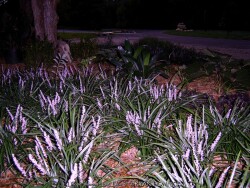

Big Blue Liriope (Liriope muscari 'Big Blue') grows to form a dense, dark green, grass-like groundcover in medium to full shade. As one of the very best "dry-shade" plants, it has environmental and economic traits that can help conserve water and lower your water bill! Plantings can thrive for decades if in the right spot; there is no such thing as overcrowding for Liriope. When planted in mass, growth is slow at first but eventually a cake-like rhizome system will form and completely smother out any weeds and compete well with trees for water and nutrients. Even under the most hostile conditions such as huge silver maple and pin oak trees, liriope not only survives but thrives. While Big Blue Liriope can tolerate full sun, they prefer part to full shade. Sun burning is possible with temperatures over 100° and there are better plants to use in hot areas. Liriope has no insect or disease problems, will survive droughts, short-term floods and cold winters. In the winter, it will stay green until 0 degrees F and be completely evergreen some winters. Liriope also thrives in summer with the worst heat and humidity even in the Southeast and Southwest! Liriope is tolerant of a wide range of soil types but prefers clay/loam and will display best growth in fertile soils with average water but extremely drought tolerant in shaded areas! For the home garden, the species spreads slowly so you shouldn't leave very much room in-between Liriope plants or you will be waiting many years for the patch to fill in. Weeds can be a problem in that open area between plants if spacing is too wide. We recommend 12-18" spacing for a larger area. The only problem we have seen is a mysterious crown-rot disease in well-irrigated gardens. This liriope (Liriope muscari 'Big Blue') does not spread very quickly or much at all compared to Spreading Liriope / Monkey Grass (Liriope spicata) This is a real trooper for the dry shade garden!


Classic Blue Clump-forming Liriope (Liriope muscari 'Classic Blue' / 'Ingwersen') grows to form a dense, dark green, grass-like groundcover in medium to full shade. As one of the very best "dry-shade" plants, it has environmental and economic traits that can help conserve water and lower your water bill! Plantings can thrive for decades if in the right spot; there is no such thing as overcrowding for Liriope. When planted in mass, growth is slow at first but eventually a cake-like rhizome system will form and completely smother out any weeds and compete well with trees for water and nutrients. Even under the most hostile conditions such as huge silver maple and pin oak trees, liriope not only survives but thrives. While Big Blue Liriope can tolerate full sun, they prefer part to full shade. Sun burning is possible with temperatures over 100° and there are better plants to use in hot areas. Liriope has no insect or disease problems, will survive droughts, short-term floods and cold winters. In the winter, it will stay green until 0 degrees F and be completely evergreen some winters. Liriope also thrives in summer with the worst heat and humidity even in the Southeast and Southwest! Liriope is tolerant of a wide range of soil types but prefers clay/loam and will display best growth in fertile soils with average water but extremely drought tolerant in shaded areas! For the home garden, the species spreads slowly so you shouldn't leave very much room in-between Liriope plants or you will be waiting many years for the patch to fill in. Weeds can be a problem in that open area between plants if spacing is too wide. We recommend 12-18" spacing for a larger area. The only problem we have seen is a mysterious crown-rot disease in well-irrigated gardens. This liriope (Liriope muscari 'Classic Blue' / 'Ingwersen') does not spread very quickly or much at all compared to Spreading Liriope / Monkey Grass (Liriope spicata) This is a real trooper for the dry shade garden!
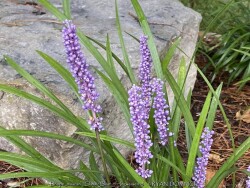

Classic Blue Clump-forming Liriope (Liriope muscari 'Classic Blue' / 'Ingwersen') grows to form a dense, dark green, grass-like groundcover in medium to full shade. As one of the very best "dry-shade" plants, it has environmental and economic traits that can help conserve water and lower your water bill! Plantings can thrive for decades if in the right spot; there is no such thing as overcrowding for Liriope. When planted in mass, growth is slow at first but eventually a cake-like rhizome system will form and completely smother out any weeds and compete well with trees for water and nutrients. Even under the most hostile conditions such as huge silver maple and pin oak trees, liriope not only survives but thrives. While Big Blue Liriope can tolerate full sun, they prefer part to full shade. Sun burning is possible with temperatures over 100° and there are better plants to use in hot areas. Liriope has no insect or disease problems, will survive droughts, short-term floods and cold winters. In the winter, it will stay green until 0 degrees F and be completely evergreen some winters. Liriope also thrives in summer with the worst heat and humidity even in the Southeast and Southwest! Liriope is tolerant of a wide range of soil types but prefers clay/loam and will display best growth in fertile soils with average water but extremely drought tolerant in shaded areas! For the home garden, the species spreads slowly so you shouldn't leave very much room in-between Liriope plants or you will be waiting many years for the patch to fill in. Weeds can be a problem in that open area between plants if spacing is too wide. We recommend 12-18" spacing for a larger area. The only problem we have seen is a mysterious crown-rot disease in well-irrigated gardens. This liriope (Liriope muscari 'Classic Blue' / 'Ingwersen') does not spread very quickly or much at all compared to Spreading Liriope / Monkey Grass (Liriope spicata) This is a real trooper for the dry shade garden!


Royal Purple Liriope (Liriope muscari 'Royal Purple') grows to form a dense, dark green, grass-like groundcover in medium to full shade. As one of the very best "dry-shade" plants, it has environmental and economic traits that can help conserve water and lower your water bill! Plantings can thrive for decades if in the right spot; there is no such thing as overcrowding for Liriope. When planted in mass, growth is slow at first but eventually a cake-like rhizome system will form and completely smother out any weeds and compete well with trees for water and nutrients. Even under the most hostile conditions such as huge silver maple and pin oak trees, liriope not only survives but thrives. While Big Blue Liriope can tolerate full sun, they prefer part to full shade. Sun burning is possible with temperatures over 100° and there are better plants to use in hot areas. Liriope has no insect or disease problems, will survive droughts, short-term floods and cold winters. In the winter, it will stay green until 0 degrees F and be completely evergreen some winters. Liriope also thrives in summer with the worst heat and humidity even in the Southeast and Southwest! Liriope is tolerant of a wide range of soil types but prefers clay/loam and will display best growth in fertile soils with average water but extremely drought tolerant in shaded areas! For the home garden, the species spreads slowly so you shouldn't leave very much room in-between Liriope plants or you will be waiting many years for the patch to fill in. Weeds can be a problem in that open area between plants if spacing is too wide. We recommend 12-18" spacing for a larger area. The only problem we have seen is a mysterious crown-rot disease in well-irrigated gardens. This liriope (Liriope muscari 'Royal Purple') does not spread very quickly or much at all compared to Spreading Liriope / Monkey Grass (Liriope spicata) This is a real trooper for the dry shade garden!
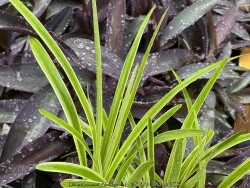

Variegated Liriope (Liriope muscari 'Variegata') grows to form a dense, dark green, grass-like groundcover in medium to full shade. As one of the very best "dry-shade" plants, it has environmental and economic traits that can help conserve water and lower your water bill! Plantings can thrive for decades if in the right spot; there is no such thing as overcrowding for Liriope. When planted in mass, growth is slow at first but eventually a cake-like rhizome system will form and completely smother out any weeds and compete well with trees for water and nutrients. Even under the most hostile conditions such as huge silver maple and pin oak trees, liriope not only survives but thrives. While Big Blue Liriope can tolerate full sun, they prefer part to full shade. Sun burning is possible with temperatures over 100° and there are better plants to use in hot areas. Liriope has no insect or disease problems, will survive droughts, short-term floods and cold winters. In the winter, it will stay green until 0 degrees F and be completely evergreen some winters. Liriope also thrives in summer with the worst heat and humidity even in the Southeast and Southwest! Liriope is tolerant of a wide range of soil types but prefers clay/loam and will display best growth in fertile soils with average water but extremely drought tolerant in shaded areas! For the home garden, the species spreads slowly so you shouldn't leave very much room in-between Liriope plants or you will be waiting many years for the patch to fill in. Weeds can be a problem in that open area between plants if spacing is too wide. We recommend 12-18" spacing for a larger area. The only problem we have seen is a mysterious crown-rot disease in well-irrigated gardens. This liriope (Liriope muscari 'Variegata') does not spread very quickly or much at all compared to Spreading Liriope / Monkey Grass (Liriope spicata) This is a real trooper for the dry shade garden!
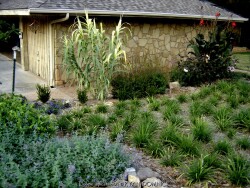

Liriope (Liriope spitica) grows to form a dense, dark green, grass-like groundcover / turf in medium to full shade. (also called "Lilyturf"). As one of the very best "dry-shade" plants, it has environmental and economic traits that cannot be disputed. A typical homeowner will save hundreds of dollars a year on lawn maintenance costs. Large turflike installations can save thousands of dollars per year. Even under the most hostile conditions such as huge silver maple and pin oak trees, liriope not only survives but thrives. Liriope has no insect or disease problems, will survive droughts, short-term floods and cold winters. Liriope has a very low water requirement and a deep root system that allows it to draw water from a large area. Liriope thrives on only 1 deep watering per month in the summer to stay green. In the winter, it will stay green until zero degrees and be completely evergreen some winters. If the top Liriope grows to form a dense groundcover / turf in medium to full shade. Liriope requires no mowing maintenance (monthly mowing is optional to achieve 4" height) Un-mowed, it will grow uniformly 8-10" and appear like a lawn from a distance. Fewer weed problems occur; the dense growth of liriope grass smothers out existing weeds and prevents the germination of new seeds. The soft texture and medium green color are great assets; evergreen to 0ºF, survives -20. Liriope grows in zones 5-9; tolerates cold in the winter and heat / humidity in the summer. Liriope is tolerant of a wide range of soil types but prefers clay/loam and will display best growth in fertile soils with average water but extremely drought tolerant in shaded areas! For the home garden, the species is generally too aggressive to mix with other plants. Use as a groundcover or lawn substitute for dry-shade.
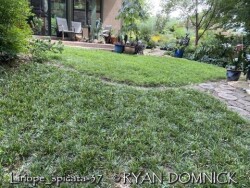

Liriope (Liriope spitica) grows to form a dense, dark green, grass-like groundcover / turf in medium to full shade. (also called "Lilyturf"). As one of the very best "dry-shade" plants, it has environmental and economic traits that cannot be disputed. A typical homeowner will save hundreds of dollars a year on lawn maintenance costs. Large turflike installations can save thousands of dollars per year. Even under the most hostile conditions such as huge silver maple and pin oak trees, liriope not only survives but thrives. Liriope has no insect or disease problems, will survive droughts, short-term floods and cold winters. Liriope has a very low water requirement and a deep root system that allows it to draw water from a large area. Liriope thrives on only 1 deep watering per month in the summer to stay green. In the winter, it will stay green until zero degrees and be completely evergreen some winters. If the top Liriope grows to form a dense groundcover / turf in medium to full shade. Liriope requires no mowing maintenance (monthly mowing is optional to achieve 4" height) Un-mowed, it will grow uniformly 8-10" and appear like a lawn from a distance. Fewer weed problems occur; the dense growth of liriope grass smothers out existing weeds and prevents the germination of new seeds. The soft texture and medium green color are great assets; evergreen to 0ºF, survives -20. Liriope grows in zones 5-9; tolerates cold in the winter and heat / humidity in the summer. Liriope is tolerant of a wide range of soil types but prefers clay/loam and will display best growth in fertile soils with average water but extremely drought tolerant in shaded areas! For the home garden, the species is generally too aggressive to mix with other plants. Use as a groundcover or lawn substitute for dry-shade.
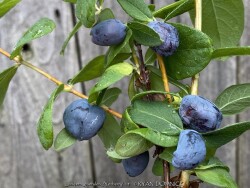

Also called Honeyberries, Japanese Haskap, or Yezberry® (Lonicera caerulea), these shrubs are easy-to-grow fruiting plants developed for their large, delicious blue fruit. Yezberry® are extremely cold hardy and able to bear fruit in zones 3-7. Plant with another Yezberry® variety for an abundant fruit set on both plants. However, as an ornamental shrub, late summer Kansas heat stress will likely cause partial to complete defoliation. This does not affect the fruit quality or overall health of the shrub as the flower buds for next year are already formed. Ultra cold-hardy plants from northern climates normally dislike our long hot humid summers; although we are on the Southern edge of this plants adaptability, it still survives reasonably well here. Look for a cold microclimate planting location such as East or North exposure. In Eastern Kansas, typically our 40 inches of rainfall is sufficient without extra water. All Proven Winners® plants are legally propagated, healthy and vigorous, true to name, and tagged with color pictures and growing information.
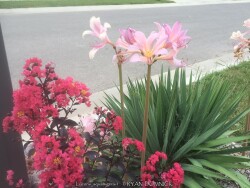

>>>>>are typically grown for their mid-summer flowers and vertical iris-leaf foliage. The plants are temperate and subtropical herbaceous perennial bulbs native to areas with a summer wet season and dry winter. Gladiolus are hardy outside as a perennial when established and with minimal effort at least up to zone 6a. During the growing season, fertilize, water regularly, and plant in full sun. Plant these bulbs in the ground at least 6-8" deep with 3-4" of mulch to enjoy a wonderful tropical flowering effect! Foliage may look bedwraggled by fall so it is ok to cut back foliage at that time. They can also be grown as a flowering summer patio plant. If growing as a potted plant and trying to overwinter, allowing the foliage to frost is ok, it will not kill the root system. However, do not allow the pot with rootball to freeze solid or go below 20 degrees for more than a few hours; move into a cold garage or basement over the winter with no watering. Cut back and allow to go dormant and place entire pot back out in April or May with a time-release fertilizer. Another more labor intensive way to overwinter gladiolus is to remove them from the dirt, dust with fungicide, place in box with sawdust, and keep in the refrigerator. We consider this method old-fashioned and too much work but ok if you only want to save a few bulbs. If digging from the ground in colder zones, just save a big chunk with the dirt intact and place into a large pot in the garage. In a customer's garden in Lawrence, KS (zone 6a), four established specimens planted over 4-6" deep and mulched 2-3" with wood mulch survived -17 degrees F. During the arctic blast of February, 2021, lows down to -17 degrees F on Feb 16th, 2021 were recorded. The longevity of this cold blast was also impressive: 10 days on a row with highs of 10-15 degrees F or lower, 8 nights of lows in the single digits and negatives, and 36 straight hours of 0 degrees F and mostly lower.
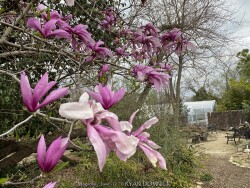

Jane Magenta Flowering Magnolia (Magnolia 'Jane'), noted for its compact, upright habit, grows best in organically rich, medium-moisture soil that's neutral to slightly acidic. Reddish purple flowers with white interiors open later in spring to avoid frost damage. Flowers do seem to tolerate light freezes down to 28 degrees that have occured here at our Lawrence, KS display garden without damage. Flowers are a gorgeous tulip shape with a lightly scented fragrance. Leaves are medium to dark green turning a beautiful gold in the fall. Jane magnolia makes a great understory small tree, specimen plant, or background shrub slowly growing 10'-15' high. Grows best in full morning sun and partially shaded afternoons in hot climates. Avoid hot West or South exposures and winds. Magnolias in general are a family of plants that have been around for millions of years and are among the most primitive of all flowers. In fact, most magnolia flowers evolved before bees and are thus pollinated by beetles. Magnolias generally grow in moist, well drained soils in sun or shade. They have no serious pests or disease problems. Occasionally seen listed as Magnolia liliflora 'Reflorescens' x stellate 'Waterlily'


***Tree descriptions available with future update!***
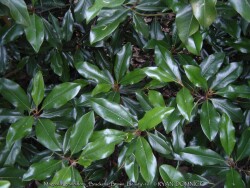

Magnolia grandiflora 'Bracken's Brown Beauty' is one of the most cold hardy of the Southern Magnolias. Magnolias in general are a family of plants that have been around for millions of years and are among the most primitive of all flowers. In fact, most magnolia flowers evolved before bees and are thus pollinated by beetles. Magnolias generally have no serious pests or diseases. Any of the dwarf Southern Magnolia cultivars serve as a beautiful four seasons small tree or large shrub. Evergreen foliage is a shiny dark green with a brown-orange back that first emerges lighter green. If temperature stay above -10°F, foliage generally stays intact. If colder than that, it will shed its leaves like a deciduous tree when new growth occurs in April. Large tropical-looking white scented flowers bloom in late May and early June. Green cones, yes cones, follow in late summer with the cones opening up to yield beautiful red seeds. Seeds are viable but will not survive the winter here. Bracken's Brown Beauty Magnolias appreciate rich well-drained soil but will tolerate less than ideal clay soils. Sandy or rocky soils are tolerated if watering is sufficient. Magnolias can tolerate short periods of poor drainage but not consistent bog like conditions. Full sun is best but WELL-CARED for Magnolias can tolerate mostly shade in rich soils. This means do not use Magnolias under walnut trees, in dry shade, or exposed to north winds on the north side of a house. Being one of the few broadleaf evergreens hardy in zone 6, Bracken's Brown Beauty has many landscape uses. Several trees planted in a row or group will make an awesome wind and visual screen without the pest problems of coniferous evergreens. If ice or snow damage occurs, Magnolias have the ability to grow back reasonably quickly as opposed to most coniferous evergreens. In fact, Magnolias will come back from the ground is completely cut down and new growth from water sprouts will be rapid. Magnolias also make a great specimen tree or background for flowers and shrubs. Magnolias can be planted near a house without worrying about damaging root systems; they are very easily pruneable if they start getting too big. This highly-rated small landscape tree is perfect somewhere on your property!
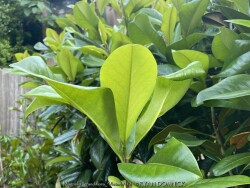

Magnolia grandiflora 'Victoria' is one of the most cold hardy of the Southern Magnolias. Magnolias in general are a family of plants that have been around for millions of years and are among the most primitive of all flowers. In fact, most magnolia flowers evolved before bees and are thus pollinated by beetles. Magnolias generally have no serious pests or diseases. Any of the dwarf Southern Magnolia cultivars serve as a beautiful four seasons small tree or large shrub. Evergreen foliage is a shiny dark green with a brown-orange back that first emerges lighter green. If temperature stay above -10°F, foliage generally stays intact. If colder than that, it will shed its leaves like a deciduous tree when new growth occurs in April. Large tropical-looking white scented flowers bloom in late May and early June. Green cones, yes cones, follow in late summer with the cones opening up to yield beautiful red seeds. Seeds are viable but will not survive the winter here. Victoria Hardy Southern Magnolias appreciate rich well-drained soil but will tolerate less than ideal clay soils. Sandy or rocky soils are tolerated if watering is sufficient. Magnolia's can tolerate short periods of poor drainage but not consistent bog like conditions. Full sun is best but WELL-CARED for Magnolias can tolerate mostly shade in rich soils. This means do not use Magnolias under walnut trees, in dry shade, or exposed to north winds on the north side of a house. Being one of the few broadleaf evergreens hardy in zone 6, Victoria Hardy Southern Magnolia has many landscape uses. Several trees planted in a row or group will make an awesome wind and visual screen without the pest problems of coniferous evergreens. If ice or snow damage occurs, Magnolias have the ability to grow back reasonably quickly as opposed to most coniferous evergreens. In fact, Magnolias will come back from the ground is completely cut down and new growth from water sprouts will be rapid. Magnolias also make a great specimen tree or background for flowers and shrubs. Magnolias can be planted near a house without worrying about damaging root systems; they are very easily pruneable if they start getting too big. This highly-rated small landscape tree is perfect somewhere on your property!


Bigleaf Magnolia (Magnolia macrophylla) features very large light green leaves that are the biggest simple leaf in North America measuring upto 36" long! They are native to pockets of the Appalachian mountains with perfect rich soils and protected from winds. One would think that plant like this would not do well in Kansas landscapes. However if given a little bit of wind protection, some watering, and decent soil, these trees will do fine and grow vigorously growing in sun or shade. Big leaf magnolias also produce large creamy white flowers and have silvery backs to their leaves adding to the appeal. With ideal conditions, a growth rate of 1 to 2 feet per year is possible. With more difficult conditions they will grow a few inches per year but still look attractive. There seems to be no other plant that can add a tropical feel like big leaf Magnolia. Magnolias in general are a family of plants that have been around for millions of years and are among the most primitive of all flowers. In fact, most magnolia flowers evolved before bees and are thus pollinated by beetles. Magnolias generally have no serious pests or diseases.


***Description for this plant available with future update!***


***Description for this plant available with future update!***
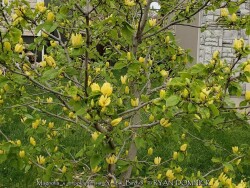

Yellow Flowering Magnolia (Magnolia x brooklynensis 'Yellow Bird') is a rare jewel in the landscape: a tree with giant canary yellow flowers! Yellow Bird is an upright, conical to pyramidal, large deciduous tree that can grow 40 feet tall in Kansas. This magnolia would be a fine residential specimen in sheltered locations with moist, rich soil with plenty of space to spread. Magnolias in general are a family of plants that have been around for millions of years and are among the most primitive of all flowers. In fact, most magnolia flowers evolved before bees and are thus pollinated by beetles. Magnolias generally grow in moist, well drained soils in sun or shade. They have no serious pests or disease problems.
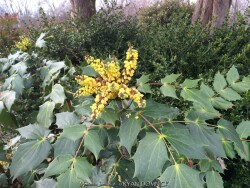

Leatherleaf Mahonia (Mahonia bealei) is a slow-growing coarse-textured evergreen shrub with bright green holly-like leaflets. The leaves are prickly and make a fine barrier or specimen plant. Native to continental climates in China, Mahonia bealei can be invasive in Eastern US woods where its shade tolerance and slow evergreen growth eventually shade out native plants. This is not a problem in Kansas due to extreme winters and dryer conditions. Flowering tries to occur in mid to late winter in Kansas but are usually frozen before they can open. During a "once in 5 years" mild winter if temperatures stay above 0 degrees F, fragrant, lemon-yellow flowers do develop. Even more rare is to have a long enough warm spell in winter to allow the beautiful blackish-blue fruit to develop afterward. If they do, they will be enjoyed by birds but any small seedlings that do germinate are killed by ground freezes the next winter. Leatherleaf Mahonia is very drought tolerant when established making it an ideal dry-shade plant; the 40 inches of typical rainfall in Eastern Kansas is sufficient if planted in rototilled soils. This could be one of the most cold-tolerant broadleaf evergreens available! It survived -16 degrees F and a week of single digit highs in February, 2021 with no damage. It even maintains bright green foliage in winter opposed to a dingy brownish-green like some evergreens. In Eastern Kansas, this species performs WELL with just about everything nature has to challenge it! Heat and drought are tolerated if in shade or morning sun. Cold tolerance is no problem. Invasiveness is not a problem. No disease or pest problems. And again, this is a great evergreen plant for difficult dry-shade situations under mature trees where lawn won't grow.


Leatherleaf Mahonia (Mahonia x media 'Marvel') is a slow-growing coarse-textured evergreen shrub with bright green holly-like leaflets. The leaves are prickly and make a fine barrier or specimen plant. Native to continental climates in China, Mahonia bealei can be invasive in Eastern US woods where its shade tolerance and slow evergreen growth eventually shade out native plants. This is not a problem in Kansas due to extreme winters and dryer conditions. Flowering tries to occur in mid to late winter in Kansas but are usually frozen before they can open. During a "once in 5 years" mild winter if temperatures stay above 0 degrees F, fragrant, lemon-yellow flowers do develop. Even more rare is to have a long enough warm spell in winter to allow the beautiful blackish-blue fruit to develop afterward. If they do, they will be enjoyed by birds but any small seedlings that do germinate are killed by ground freezes the next winter. Leatherleaf Mahonia is very drought tolerant when established making it an ideal dry-shade plant; the 40 inches of typical rainfall in Eastern Kansas is sufficient if planted in rototilled soils. This could be one of the more cold-tolerant broadleaf evergreens available! 'Marvel' survived -16 degrees F and a week of single digit highs in February, 2021 but with complete foliage loss. It even maintains bright green foliage in winter opposed to a dingy brownish-green like some evergreens. In Eastern Kansas, this species performs WELL with just about everything nature has to challenge it! Heat and drought are tolerated if in shade or morning sun. Cold tolerance is no problem. Invasiveness is not a problem. No disease or pest problems. And again, this is a great evergreen plant for difficult dry-shade situations under mature trees where lawn won't grow. Mahonia x media 'Marvel' is an improved cultivar that is more compact than other varieties. Evergreen foliage is a medium glossy green and more fine-textures compared to the species. Frond-like leaves develop in whorls and are arranged along coarsely branched stems creating an architectural effect. It is unknown at this point (2022) if flowers and fruit will develop here in Kansas zone 6a but it is doubtful seeing how it tries to bloom in the winter similar to the species.
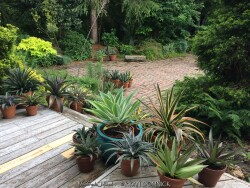

The variety of foliage colors and patterns make Mangave excellent architectural specimen plants. Mangave is a relatively new phenomenon, as a cross between the genus Manfreda and Agave. These rare hybrids combine the best of both worlds: the better growth rate and the interesting patterns of Manfreda, and the habit and refinement of Agave. Usually used as a patio or house plant in Kansas, they can also be grown as an annual. Grow in full sun to part sun with optional extra watering including that which comes from rainfall. Plants with time to acclimate will thrive in full sun but be careful not to rush it or sunburning will occur. Generally if moving outside for the summer, allow 2-3 weeks of part shade or morning sun before placing in full sun. Repotting may or may not be needed depending on how large you want the plant to grow; plants can continue to grow and tolerate extremely root-bound pots. Protect from temperatures below 35 degrees F and move into a bright window over the winter with no watering. Do not allow Mangave in pots to freeze solid or get close to freezing especially if soil is wet or death may occur. As a winter house plant, it will look presentable all winter long with just a few monthly or no waterings if you forget. As a permanent house plant, provide bright light and allow the soil to dry between waterings for many years of carefree enjoyment. Potted plants are very low maintenance needing only old leaves trimmed once per year. This is not at all a big-box store plant so be prepared to expand your plant palette with Mangave!
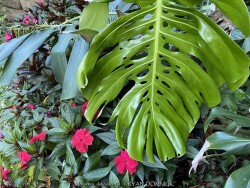

Split Leaf Philodendron / Swiss Cheese Plant (Monstera deliciosa) is a large tropical plant. This member of the arum family Araceae is an epiphyte with aerial roots, able to grow up to 66 ft high in the wild, with large, leathery, glossy, pinnate, heart-shaped leaves 12-36" ft long by 12-30" broad. The leaves on young plants are smaller and entire with no lobes or holes, but soon produce lobed and fenestrate leaves as they grow. Although it can grow very tall in nature, it only measures between 6-10 ft) when grown indoors. The older the plant, the more the leaves are covered with its familiar large perforations. This plant lives in the humid tropical forests, in the lowlands and middle mountains, in the extreme south of Mexico, Central America, and south tip of Florida. The seeds fall to the ground, then the seedlings grow towards the dark (negative phototropism) until they meet a tree on which to attach. The many adjacent roots thus allow the plant to anchor against its new support and reach the canopy light (although it rarely grows in full sun and prefers a light dimmed by the foliage). Monstera deliciosa is commonly grown outdoors as an ornamental plant in the tropics and subtropics. The plant requires a lot of space and a rich and loose soil (ideally garden soil and compost in equal parts). If it grows in the ground it is better to plant it near a tree, where it can climb, if not against a trellis. It is moderately greedy and needs to be watered just to keep the soil slightly moist. Hardy to zone 11, it cannot withstand freezing temperatures for more than a few hours. A steady minimum temperature of at least 55-59°F is preferable, allowing continuous growth. Growth ceases below 50°F but tolerant down to 32°F if kept on the dry side. Its architectural qualities, ease of cultivation, and tolerance of a wide range of conditions make it an ideal plant for indoor cultivation as well. For this reason it is a popular plant for the home or office throughout the temperate northern hemisphere. It prefers bright indirect light and temperatures of 68-86°F. Flowering is rare when grown indoors. Along with other tropicals and succulents in Kansas, Split Leaf Philodendron / Swiss Cheese Plant is usually grown as large summer patio plant. Water regularly and place in full shade or very limited morning sun possibly in a large ceramic pot under an established shade thee for the summer. They handle the transition moving in and out rather well and hold up nicely during winter if you have dark, cold, or un-ideal conditions provided that they get a good growing season outdoors for 1/2 the year.
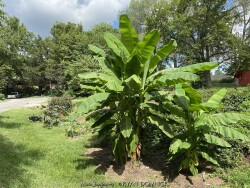

Create a tropical effect in your landscape with these large fast-growing cold hardy Musa basjoo! (also called Japanese fiber banana) Each leaf can be 6 feet long and 2 feet wide. Leave in ground and mulch 6" thick and they will return as perennials every year. If planting on the south side of a house in full sun, little protection is needed. These have proven hardy in Lawrence, KS (zone 6a) for over 20 years. In Eastern Kansas, typically our 40 inches of rainfall is sufficient without extra water in good soils. This species will tolerate some degree of drought but fastest growth will occur in rich well-drained soils with extra water and fertilizer provided during the summer. Great for summer wet areas in full sun or around swimming pools (creates no messes). Plants are capable of growing 15-18 feet by the end of summer when established and happy! A more realistic height is 7-12 feet under average conditions. Banana trees will slowly divide and send up offsets; this is a desirable sign that the banana tree is establishing well. If 1-2 feet of trunk is protected with a large pile of leaf mulch, you will get a flower followed by small inedible bananas the 2nd year on the largest trunk. The flowering trunk will die but the offsets will grow. Bananas will not tolerate excessively wet soils during dormancy. Sunburning can happen with summer temperatures over 100 degrees F but it will quickly outgrow the damage. Bananas need at least 1/2 day of full sun and protection from excessive winds to properly grow. Listed by many sources as hardy to zone 6 or 7, with proper mulching and placement near a foundation, you can easily grow this into zone 5 or possibly lower. In our trial gardens in Lawrence, KS (zone 6a), two well established specimens have thrived for 15 years and counting. During the arctic blast of February, 2021, lows down to -17 degrees F on Feb 16th, 2021 were recorded. The longevity of this cold blast was also impressive: 10 days on a row with highs of 10-15 degrees F or lower, 8 nights of lows in the single digits and negatives, and 36 straight hours of 0 degrees F and mostly lower. A hard ground freeze was inevitable; hundreds of plants around town survived this event returning a little late the following spring but otherwise just fine. Some were mulched with ground up leaf mulch, some were not.
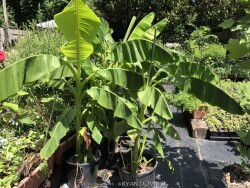

Create a tropical effect in your landscape with these large fast-growing cold hardy Musa basjoo! (also called Japanese fiber banana) Each leaf can be 6 feet long and 2 feet wide. Leave in ground and mulch 6" thick and they will return as perennials every year. If planting on the south side of a house in full sun, little protection is needed. These have proven hardy in Lawrence, KS (zone 6a) for over 20 years. In Eastern Kansas, typically our 40 inches of rainfall is sufficient without extra water in good soils. This species will tolerate some degree of drought but fastest growth will occur in rich well-drained soils with extra water and fertilizer provided during the summer. Great for summer wet areas in full sun or around swimming pools (creates no messes). Plants are capable of growing 15-18 feet by the end of summer when established and happy! A more realistic height is 7-12 feet under average conditions. Banana trees will slowly divide and send up offsets; this is a desirable sign that the banana tree is establishing well. If 1-2 feet of trunk is protected with a large pile of leaf mulch, you will get a flower followed by small inedible bananas the 2nd year on the largest trunk. The flowering trunk will die but the offsets will grow. Bananas will not tolerate excessively wet soils during dormancy. Sunburning can happen with summer temperatures over 100 degrees F but it will quickly outgrow the damage. Bananas need at least 1/2 day of full sun and protection from excessive winds to properly grow. Listed by many sources as hardy to zone 6 or 7, with proper mulching and placement near a foundation, you can easily grow this into zone 5 or possibly lower. In our trial gardens in Lawrence, KS (zone 6a), two well established specimens have thrived for 15 years and counting. During the arctic blast of February, 2021, lows down to -17 degrees F on Feb 16th, 2021 were recorded. The longevity of this cold blast was also impressive: 10 days on a row with highs of 10-15 degrees F or lower, 8 nights of lows in the single digits and negatives, and 36 straight hours of 0 degrees F and mostly lower. A hard ground freeze was inevitable; hundreds of plants around town survived this event returning a little late the following spring but otherwise just fine. Some were mulched with ground up leaf mulch, some were not.
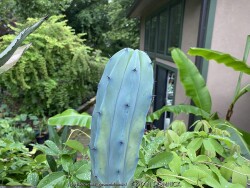

Blue Candle Cacti (Myrtillocactus geometrizans ) are known for its brilliant powder blue skin. If you touch it however, the powdery silver color permanently rubs off leaving a green skin underneath. Native to tropical deciduous forests in Mexico, it's usually grown as a patio or house plant in Kansas. In the wild, established blue candle cacti are hardy to 25 degrees F for short periods of time. Grow in full sun with occasional extra watering including that which comes from rainfall. Repotting may or may not be needed depending on how large you want the plant to grow; plants can continue to grow taller and tolerate extremely root-bound pots but may need wind bracing. If repotting, make sure to use a sharp draining medium organic cactus mix with plenty of sand and perlite. To play is safe, potted plants are best moved in before night temperatures get below 45 degrees F. It is important to avoid the combination of wet and cold. Before extreme cold occurs, move to a bright interior window over the winter with no watering and keep above freezing. As a winter house plant, it will look presentable all winter long with just no waterings. As a permanent house plant, provide bright light and allow the soil to dry between waterings for many years of carefree enjoyment. Plants grown permanently indoors may begin to elongate stretching for light and lose their spine color. It can be hard to reproduce the intense UV sunlight they need so moving outside for the summer is best. Generally if moving outside for the summer, allow 1-2 weeks of part shade or morning sun before placing in full sun. Plants with time to acclimate will thrive in full sun but be careful not to rush it or sunburning will occur. Potted plants are very low maintenance. I have never seen any insect problems on this plant.
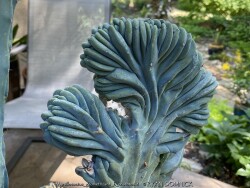

Dinosaur Back Cactus (Myrtillocactus geometrizans f. cristatus) are known for its brilliant powder blue skin on stems that crest and create waves as it grows. If you touch it however, the powdery silver color permanently rubs off leaving a green skin underneath. Native to tropical deciduous forests in Mexico, it's usually grown as a patio or house plant in Kansas. In the wild, established plants are hardy to 25 degrees F for short periods of time. Grow in full sun with occasional extra watering including that which comes from rainfall. Repotting may or may not be needed depending on how large you want the plant to grow; plants can continue to grow taller and tolerate extremely root-bound pots but may need wind bracing. If repotting, make sure to use a sharp draining medium organic cactus mix with plenty of sand and perlite. To play is safe, potted plants are best moved in before night temperatures get below 45 degrees F. It is important to avoid the combination of wet and cold. Before extreme cold occurs, move to a bright interior window over the winter with no watering and keep above freezing. As a winter house plant, it will look presentable all winter long with just no waterings. As a permanent house plant, provide bright light and allow the soil to dry between waterings for many years of carefree enjoyment. Plants grown permanently indoors may begin to elongate stretching for light and lose their spine color. It can be hard to reproduce the intense UV sunlight they need so moving outside for the summer is best. Generally if moving outside for the summer, allow 1-2 weeks of part shade or morning sun before placing in full sun. Plants with time to acclimate will thrive in full sun but be careful not to rush it or sunburning will occur. Potted plants are very low maintenance. I have never seen any insect problems on this plant. Dino is rare and will command a higher price than most other houseplants.


Nandina domestica is also called "Nandina" or "Heavenly Bamboo" despite not spreading or being related to bamboo at all. It is native to warm temperate climates in China. Bamboo-like foliage is very attractive with new growth emerging coppery peach with shades of pink and red in spring. During the summer, the foliage maintains a glossy deep to medium green color with no pest problems. White flowers appear which eventually turn into red fruits in the fall. Most birds do not like the fruit so they persist very well into winter down to about 0° F before freeze-drying to a reddish brown color and falling off. Often around Christmas time, the berries make a spectacular show combining classic colors of red and green in the winter landscape. The berries can be poisonous to some birds if they eat too many and all other food sources are depleted. This is a problem in your yard, please remove the fruits in the winter or before we have an arctic blast in which birds get desperate and will eat anything. The foliage is evergreen down to about -5° F and if colder, will simply become a deciduous shrub that year. If winter temperatures reach -10 or with strong winds, nandina will die to the ground like a perennial and come up from the base in April. In some parts of the country where winterkill never happens, nandina are invasive. (fruits spread by birds) This is likely in the Southeast and Texas south of zone 8b with plenty of rainfall. In those areas nandina will slowly take over the forest and displace native plants. There are many fruitless cultivars that can be used if invasiveness is a problem. In Kansas and in zone 5-7, This is never a problem because extreme winters keep the plant "in-check" and kill any seedlings trying to germinate. This shrub has a four-season appeal and is great for adding interest to Kansas landscapes in the winter. Best growth in Lawrence, KS (zone 6a) occurs when planted on South or West exposures benefiting from the hot micro climate. Nandina will also grow in just about any soil with full shade to full sun. If planted in full shade, growth will be very slow and extreme winters may kill them if not established; plant in spring only in this situation. Nandina look best in small to large groups. After established, its a "once it's there it's there forever" plant with very little maintenance. The only maintenance is cutting back winter kill occasionally or pruning to a more desirable mounded shape. It is worth noting that dwarf fruitless cultivars are less hardy in marginal zone 6 climates because of reduced ability to quickly recover from an occasional extreme winter.